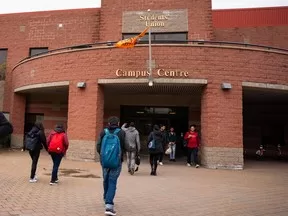The foreign student cap could cost the region 2,231 full-time equivalent jobs and $20 million in taxes
Article content
Ottawa’s cap on foreign student permits will cost Atlantic Canadian universities nearly 3,000 students and make $163 million in spending disappear from the region, according to a report released by the Association of Atlantic Canadian Universities.
The 15-page report by Gardner Pinfold Consultants Inc. of New Brunswick said it will also cost the region 2,231 full-time equivalent jobs and $20 million in provincial tax revenue.
Advertisement 2
Article content
Patrick Brannon, a senior researcher at the Atlantic Economic Council, said the report shows just how important international students are to the economy.
The report looked at three major areas of spending, including university expenses such as tuition and meals, living expenses and money spent by friends and family of students visiting the region throughout the school year.
“The main point is that it’s a big impact on universities and other postsecondary institutions,” Brannon said. “It’s going to spill through to the economy. Fewer international students means fewer people spending on retail, food and rent. That all kind of trickles through the economy and so it does make a significant difference.”
The report said enrolment this September in the region is down by 2,983 students to 23,237 because of the cap. Nova Scotia universities had the biggest decrease, with 2,091 fewer students, followed by Newfoundland and Labrador, which had a drop of 747 students.
Cape Breton University, led by David Dingwall, a former federal Liberal cabinet minister and ex-boss of the Royal Canadian Mint, will lose more than 1,100 students.
Article content
Advertisement 3
Article content
The university has worked hard to recruit foreign students. Of the 9,100 students enrolled this year, more than three-quarters are from outside the country. Six years ago, the university had only 3,500 students.
This past year, there was a serious shortage of student housing as the university coped with overcrowding. A local Cineplex was even opened as a makeshift classroom. The university said its goal is to reduce enrolment to 7,000 students by 2027.
The effect of the reduction is probably being felt elsewhere as well. A Global Affairs Canada report released in June showed that international students contributed $30.9 billion to Canada’s economy and supported 360,000 jobs in 2022.
But international students were in trouble as soon as the pandemic passed. The federal government had increased immigration to fill lower-paying jobs that no one else wanted. Those jobs were taken on by temporary foreign workers and by international students, who by last year numbered more than 26,000 at Atlantic Canada universities alone. But the increase came with a price.
“It created a huge influx in our population and the housing situation got out of control,” Brannon said.
Advertisement 4
Article content
Then came the crackdown. This year, Ottawa set out to reduce the number of temporary residents to five per cent by 2026 from 6.2 per cent of the population. At the same time, Immigration Minister Marc Miller announced a two-year plan to cut the number of study permits issued to international students by 35 per cent. It’s since been cut an another 10 per cent for next year.
International students were caught in the crossfire, Brannon said.
The association said Ottawa’s doubling down on enrolment cuts has had a “devastating effect” on many of the region’s 16 universities. The latest cut was “most distressing,” Rob Summerby-Murray, chair of the association and Saint Mary’s University’s president, said.
“The lack of recognition among IRCC officials for the incredibly negative implications this additional reduction in study permits will have on our institutions and region is disappointing,” he said in a press release.
Brannon said the value of international students doesn’t just come down to dollars and cents. The region is reliant on immigration and foreign students are an important part of that.
Advertisement 5
Article content
“We do have labour force challenges, and we’re kind of pulling back on one of those areas that are helping to maintain our labour force,” he said. “We also have an older population in Atlantic Canada and in Nova Scotia, so it’s something that we have to continue to deal with.”
Ontario colleges are also struggling to cope with the impact of the policy. Colleges Ontario said enrolment at the province’s colleges has been cut in half compared to last year.
That has Colleges and Universities Minister Nolan Quinn concerned, particularly when it comes to filling shortages in the labour market.
Brannon believes the problem facing universities is shared. Neither governments nor universities, in some cases, did enough planning to ensure adequate housing was in place to accommodate the influx of foreign students.
Recommended from Editorial
In the end, he said a temporary cap is a good strategy that will help ease housing shortages and bring stability to universities in the region.
“International students are a great source of permanent residents down the road. It’s part of what we need to continue to grow our population and that can’t be overlooked,” he said.
• Email: arankin@postmedia.com
Bookmark our website and support our journalism: Don’t miss the business news you need to know — add financialpost.com to your bookmarks and sign up for our newsletters here.
Article content
